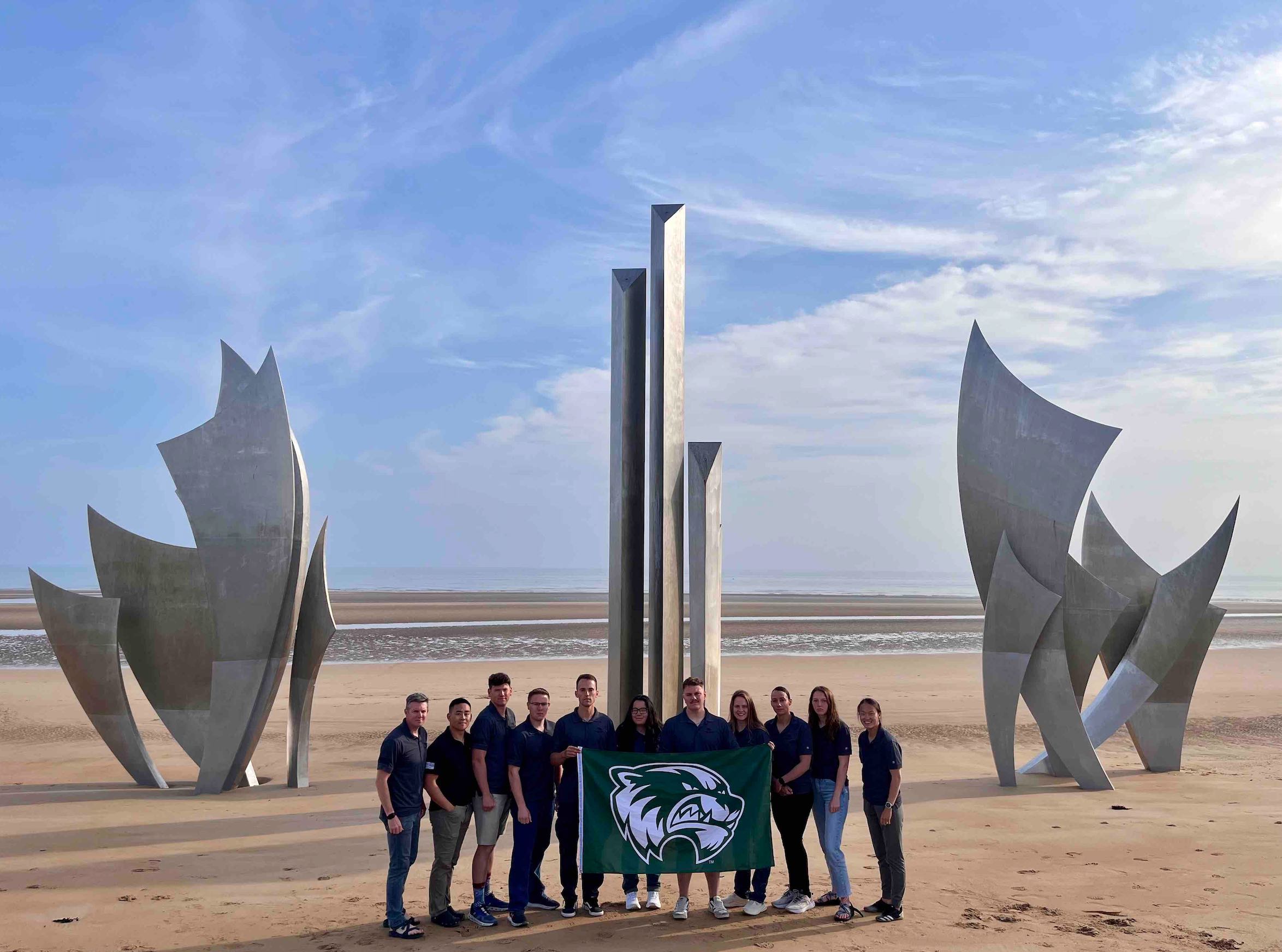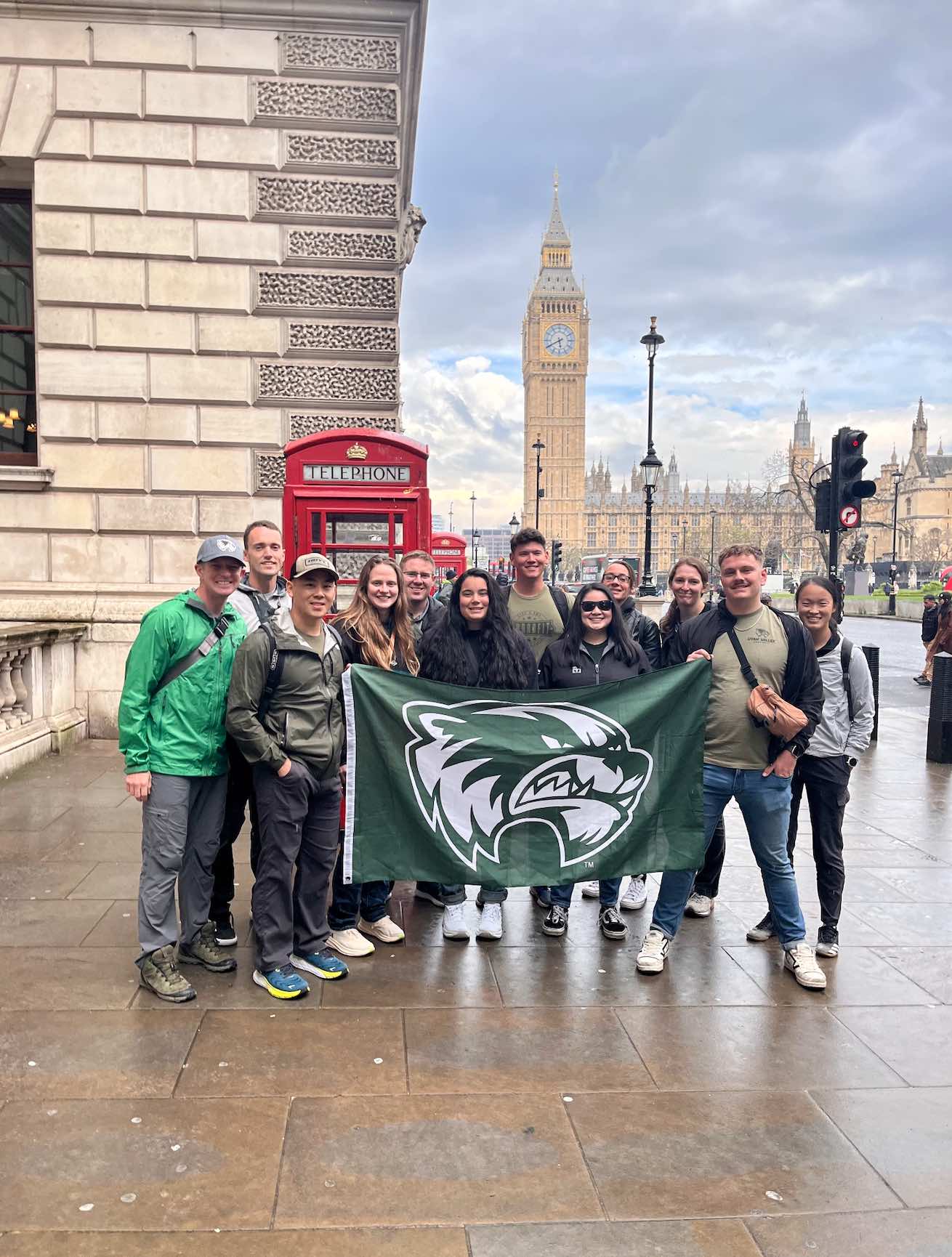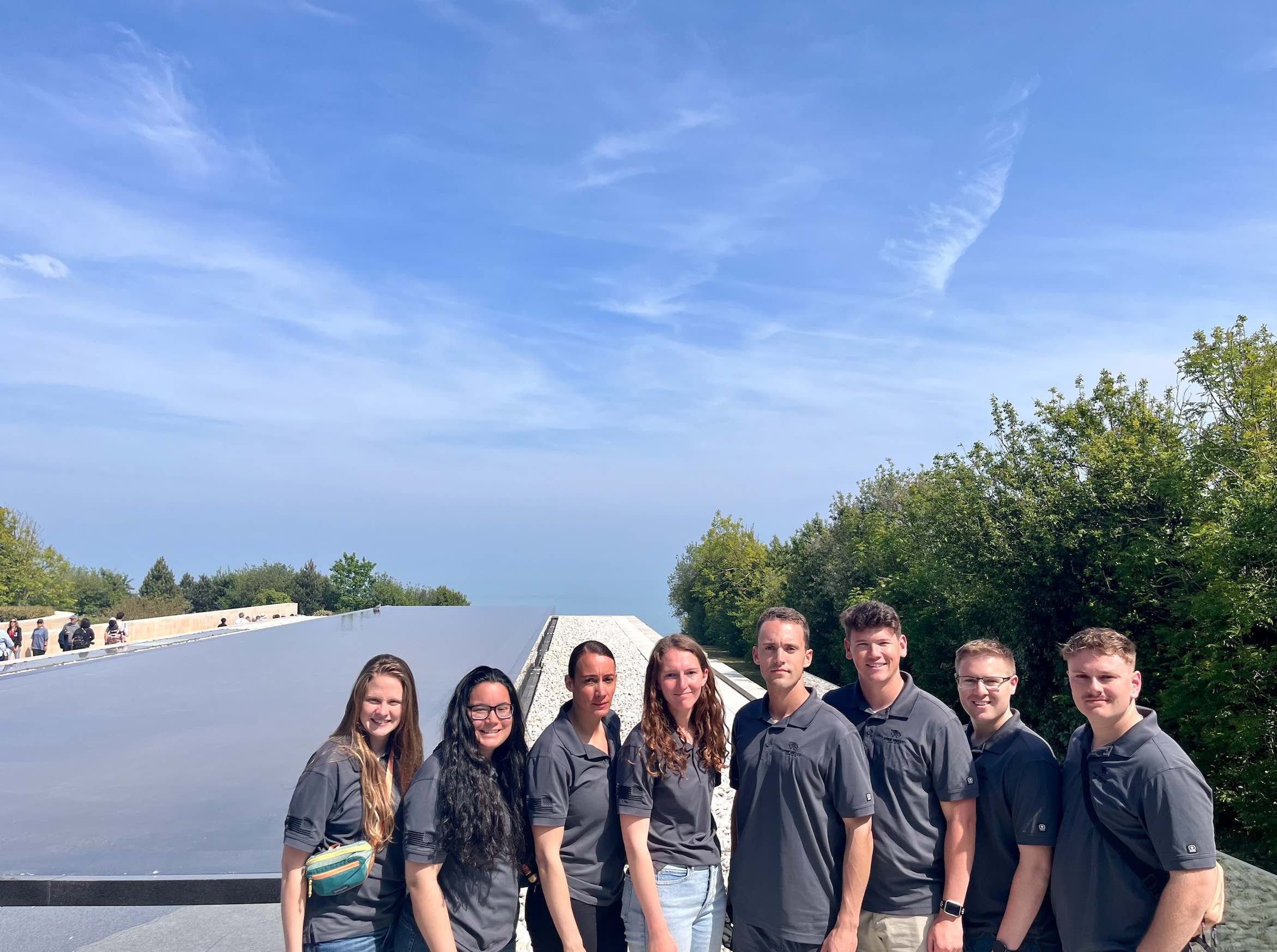

Eight cadets from the Utah Valley University (UVU) Army Reserves Officer Training Corps (ROTC) embarked on a transformative journey to London and Normandy, retracing the path of the Allies' invasion of France on D-Day from May 4-12, 2024. This staff ride offered profound insights into the courage, sacrifice, and leadership that defined this pivotal moment in history. Through their reflections, we see how each location visited left an indelible mark on their understanding and appreciation of the operations conducted.
 The journey began in London, where the cadets explored the Churchill War Rooms and
the Imperial War Museum. These sites provided a comprehensive overview of World War
II, highlighting the strategic decisions and immense challenges faced by the Allied
leaders. Cadet Alyssa Clayton, who was not well-versed in World War II history, found
herself immersed in the profound weight of history. "Ordinary men doing extraordinary
things that will be studied, analyzed, and glorified by generations to come," she
reflected. "Meeting key leaders like Winston Churchill and US General Dwight D. Eisenhower
inspired me to lead with steadfastness and courage." These museums illustrated the
immense strategic planning and resilience required to overcome the Axis powers.
The journey began in London, where the cadets explored the Churchill War Rooms and
the Imperial War Museum. These sites provided a comprehensive overview of World War
II, highlighting the strategic decisions and immense challenges faced by the Allied
leaders. Cadet Alyssa Clayton, who was not well-versed in World War II history, found
herself immersed in the profound weight of history. "Ordinary men doing extraordinary
things that will be studied, analyzed, and glorified by generations to come," she
reflected. "Meeting key leaders like Winston Churchill and US General Dwight D. Eisenhower
inspired me to lead with steadfastness and courage." These museums illustrated the
immense strategic planning and resilience required to overcome the Axis powers.
Continuing to Normandy, the cadets visited Pegasus Bridge, where its capture by British airborne troops marked a significant triumph on D-Day. This operation was critical in preventing German counterattacks during the early hours of the invasion. Cadet Noah Lowery, deeply moved by this visit, reflected on the sacrifice and valor of the soldiers. "All those who gave their lives were a spark in another soldier's heart and soul to keep pushing," he said. "We cannot forget those who gave their lives because they can still give us that spark today." The success of defending Pegasus Bridge underscored the importance of determination and precise execution in military operations.
At Pointe du Hoc, the cadets witnessed the formidable cliffs scaled by the Rangers
under heavy enemy fire. This strategic point was heavily fortified by the Germans and posed a significant threat to the
landing beaches. Cadet Bethany Schulthies was particularly struck by this site, reflecting
on the courage and determination it took to accomplish such a feat. "These men were
heroes because their courage outweighed the odds. They had the courage to try, and
that is a powerful thing," she noted. "This attribute will help me on my own hero’s
journey, especially starting this summer with CST and beyond." During each summer,
cadets attend Cadet Summer Training in which they demonstrate learned leadership and
military skills to become qualified Army officers.
point was heavily fortified by the Germans and posed a significant threat to the
landing beaches. Cadet Bethany Schulthies was particularly struck by this site, reflecting
on the courage and determination it took to accomplish such a feat. "These men were
heroes because their courage outweighed the odds. They had the courage to try, and
that is a powerful thing," she noted. "This attribute will help me on my own hero’s
journey, especially starting this summer with CST and beyond." During each summer,
cadets attend Cadet Summer Training in which they demonstrate learned leadership and
military skills to become qualified Army officers.
In Sainte-Mère-Église, the cadets visited the Airborne Museum, which commemorates the 82nd and 101st Airborne Divisions that parachuted into Normandy. This town was one of the first to be liberated on D-Day, thanks to the efforts of these paratroopers. Cadet Casey Salgado felt a deep connection to her own service as a paratrooper. "As I explored the airborne museum and learned about the daring operations of the 82nd Airborne Division, I felt a deep connection to my own service as a paratrooper," she shared. "Though I've never jumped into combat, knowing that I'm part of a legacy of courage and resilience fills me with pride and purpose." The museum highlighted the critical role airborne operations played in the success of the invasion.
At Utah Beach, the cadets reflected on the successful landings, which were crucial in establishing a foothold in Nazi-occupied France. The operation here was more successful than at Omaha Beach, with fewer casualties and quicker advancements inland. Cadet Cameron Peterson found this site particularly poignant, reflecting on the broader strategic context of the war. "The feelings that accompany each of these sites are incomparable," he said. "I have never felt the way that I did when visiting each place. The multitude of soldiers that participated in the invasion and the bravery of those who paid the ultimate price gave us the world we know today." The landings at Utah Beach underscored the importance of strategic planning and coordination in military success.
 Omaha Beach, known for its brutal and intense fighting, left a profound impact on
the cadets. The site of the highest death toll on D-Day Omaha Beach was where the
Allies faced the strongest German defenses. Cadet Alyson Lambert was deeply moved
by this site. "Omaha Beach was humbling," she reflected. "Despite the picture of despair
that I can only imagine lined that beach, they charged forward, progressing inch by
inch to take the beach and the hilltop where so many of them lay now." The perseverance
and bravery displayed at Omaha Beach exemplified the ultimate sacrifice made by many
soldiers for the greater good.
Omaha Beach, known for its brutal and intense fighting, left a profound impact on
the cadets. The site of the highest death toll on D-Day Omaha Beach was where the
Allies faced the strongest German defenses. Cadet Alyson Lambert was deeply moved
by this site. "Omaha Beach was humbling," she reflected. "Despite the picture of despair
that I can only imagine lined that beach, they charged forward, progressing inch by
inch to take the beach and the hilltop where so many of them lay now." The perseverance
and bravery displayed at Omaha Beach exemplified the ultimate sacrifice made by many
soldiers for the greater good.
The final stop at the Normandy American Cemetery allowed the cadets to pay their respects to the fallen soldiers. Located above Omaha Beach, this cemetery is a poignant reminder of the cost of freedom. The solemn sight of the headstone rows stirred profound reverence within each cadet as the national anthem played during a wreath-laying ceremony orchestrated by the American Battle Monuments Commission. The hushed atmosphere among those in attendance echoed deep respect and homage every nation paid to the over 9,000 fallen heroes of that fateful day. Cadet Zachary McEwan reflected, “I have a deeper appreciation for the mantle of Freedom and what I am truly doing as a soldier in the United States Army.” This sacred cemetery stands as an eternal testament to the unwavering valor and selfless sacrifice of the Allied Forces.
The staff ride to Normandy and London was not just a historical exploration for the UVU Army ROTC cadets, but also a journey of personal growth and reflection. Each location offered a unique perspective of the events that occurred, demonstrating the transformative power of courage, sacrifice, and leadership. Cadet Gavin Sturgeon contemplated the trip with “I will forever remember my time abroad, honoring those who never came home. To the lost generation, no words can I offer greater than thank you.” These reflections, grounded in the experiences of ordinary men and women who accomplished extraordinary feats, will guide these cadets as they prepare for their future roles in the Army and beyond. (U.S. Army Cadet Casey Salgado, UVU ROTC)

